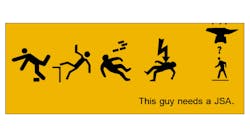Most of the time, I sit at a desk and stare at my computer. For many other organizations, however, being a desk jockey will not get products made, nor will it be productive for everyone. Most manufacturing jobs have inherent risks, whether directly related to product manufacturing or simply workplace hazards that exist throughout the facility.
Historically, companies often took a fairly broad approach to workplace safety. Safety managers would focus on the broad level of hazards and then apply them to the general work area of their employees and put controls or PPE in place as a result. Now, technology and processes have evolved to enable a much more poignant way to drive safety in the job with Job Safety Analysis (JSA) tools.
Essentially, the JSA takes a specific job, breaks it into the individual job steps and assesses the potential hazards with those steps. If the hazard is too high, then managers put controls in place to effectively reduce that hazard to acceptable levels. The idea is that once you’ve reduced the risks associated with each job step, the overall risk that the job poses is mitigated to appropriate levels.
In a small scale, this is a logical and effective measure. However, when you have thousands of employees and thousands of job types in your company, maintaining JSAs become cumbersome as a manual task. That is why technology has jumped in to ease the burden of updating JSAs, JSA reporting and creating a comprehensive JSA program. Here are five ways technology is growing the JSA trend.
1. Risk Management Quantifies Job Hazards: In many cases, no job is completely safe. Heck, I could fall out of my computer chair right here and injure myself. While JSA attempts to identify potential job hazards, it needs a method for determining the severity of the hazard and rating the safety level. Risk assessment and risk management are designed to solve this. Risk provided a systematic set of criteria that provide risk levels, usually based on severity and frequency of the hazard. Based on these levels, organizations can quantitatively determine the overall risk of a job step. Based on the risk levels, they can make better decisions on how to control these risks.
2. Job Safety Linked to Document Control: Each job step and type is associated with documentation. Most often, people are not memorizing their job steps; they need to be documented and controlled so that all processes, job descriptions, work instructions and others are the most relevant and up to date. Linking a JSA record to Document Control not only provides direct relation to the job and the procedures that associated with it, it also provides a centralized place to maintain and modify your job safety program.
3. JSA Controls Linked to Employee Training: Just because you’ve create a safe job analysis doesn’t mean it will actually work. It may work on paper (or computer screen, in this case), but unless you’ve effectively trained your employees on operating in a safe manner, it is just an analysis. To be truly effective, new job procedures, new PPE requirements and similar effects from a JSA need to be linked to training activities. This way, when a JSA is completed, your employees automatically are trained and knowledgeable on the new requirements.
4. Regular Reviews/Audits of the JSA Program: Even though you’ve set up a winning JSA program, this does not mean you are completely safe forever. Like everything in this world, change is always happening, and as your organization evolves, so too must your JSA. Technology facilitates automatic reviews of your JSA program, enabling you to regularly review the processes and ensure that the JSA you created before are still valid today.
5. Reporting on Your JSA Program: Frequently overlooked, but extremely important, is the reporting aspect of the JSA program. The key is to be able to identify how effective the JSA controls are against EHS data coming in. If you are seeing a trend that suggest there are still high levels of risk in your job safety program, then you need to be able to identify, mitigate and prevent it immediately. Reporting tools help to identify these events and provide real-time visibility into the EHS system.
Sitting here at my desk, I probably have a low-risk job (although that stapler looks pretty dangerous). But for those jobs that have real, quantifiable hazards, it is important to take measure to ensure they are safe. Technology can provide a comprehensive, integrated framework for managing job safety, taking action to document and train against JSA controls and effectively reviewing and changing your JSA programs as your organization evolves.
Tim Lozier has an extensive background in software technology and has been involved in the creation of leading-edge technologies in user-interface design and development. He is responsible for fostering the development of leading quality management software solutions, and has helped shape EtQ’s strategic vision. He provides strategic leadership for EtQ, enterprise quality and environmental health and safety management software for identifying, mitigating and preventing high risk events through integration, automation and collaboration.

